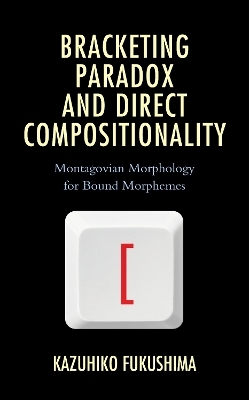
Bracketing Paradox and Direct Compositionality
Montagovian Morphology for Bound Morphemes
Seiten
2021
Lexington Books (Verlag)
978-1-4985-8810-2 (ISBN)
Lexington Books (Verlag)
978-1-4985-8810-2 (ISBN)
Bracketing Paradox and Direct Compositionality resolves bracketing paradoxes in Japanese through semantically reinforced morphology proper and without complex syntactic supposition or manipulation. Direct Compositionality and lexicalism are maintained in the domain of morpho-semantic interface thanks to Montagovian apparatus.
In Bracketing Paradox and Direct Compositionality: Montagovian Morphology for Bound Morphemes, Kazuhiko Fukushima resolves bracketing paradoxes in Japanese—morphological vs. semantic incongruity, which supposedly pose insurmountable obstacles to traditional and simple-minded morphology—within morphology (the lexicon) proper. This resolution is achieved through formal semantic apparatus developed by Richard Montague and his followers, hence the label Montagovian Morphology. More generally and theoretically, this book addresses the issue of the optimal interface between morphology, which deals with minimal units of meaning and their combination within a word, and semantics, handles increasingly larger units of meaning in the sentence. Fukushima argues that the nature of the interface is directly compositional, requiring no complex syntactic supposition or manipulation other than putting words together as is. The author concludes that a semantically reinforced morphological—that is, lexical—approach is superior to a syntactic one for characterizing the mapping between morphological and semantic domains, and that syntax per se cannot supersede morphology.
In Bracketing Paradox and Direct Compositionality: Montagovian Morphology for Bound Morphemes, Kazuhiko Fukushima resolves bracketing paradoxes in Japanese—morphological vs. semantic incongruity, which supposedly pose insurmountable obstacles to traditional and simple-minded morphology—within morphology (the lexicon) proper. This resolution is achieved through formal semantic apparatus developed by Richard Montague and his followers, hence the label Montagovian Morphology. More generally and theoretically, this book addresses the issue of the optimal interface between morphology, which deals with minimal units of meaning and their combination within a word, and semantics, handles increasingly larger units of meaning in the sentence. Fukushima argues that the nature of the interface is directly compositional, requiring no complex syntactic supposition or manipulation other than putting words together as is. The author concludes that a semantically reinforced morphological—that is, lexical—approach is superior to a syntactic one for characterizing the mapping between morphological and semantic domains, and that syntax per se cannot supersede morphology.
Kazuhiko Fukushima is professor of linguistics at Kansai Gaidai University.
The List of Abbreviations
Preface
Chapter 1: Compositionality and Montagovian Morphology
Chapter 2: Size-Morphemes and Inalienable Possession
Chapter 3: Verbal Morphemes in Suspended Affixation
Chapter 4: The Negative Morphemes -nai and its Scope
Chapter 5: Compositionality and Bound Morphemes
References
| Erscheinungsdatum | 17.05.2021 |
|---|---|
| Verlagsort | Lanham, MD |
| Sprache | englisch |
| Maße | 159 x 236 mm |
| Gewicht | 572 g |
| Themenwelt | Schulbuch / Wörterbuch ► Wörterbuch / Fremdsprachen |
| Geisteswissenschaften ► Psychologie ► Allgemeine Psychologie | |
| Geisteswissenschaften ► Psychologie ► Verhaltenstherapie | |
| Geisteswissenschaften ► Sprach- / Literaturwissenschaft ► Sprachwissenschaft | |
| ISBN-10 | 1-4985-8810-7 / 1498588107 |
| ISBN-13 | 978-1-4985-8810-2 / 9781498588102 |
| Zustand | Neuware |
| Informationen gemäß Produktsicherheitsverordnung (GPSR) | |
| Haben Sie eine Frage zum Produkt? |
Mehr entdecken
aus dem Bereich
aus dem Bereich
wie Affekte innere Entwicklung ermöglichen
Buch | Softcover (2023)
Klett-Cotta (Verlag)
30,00 €


